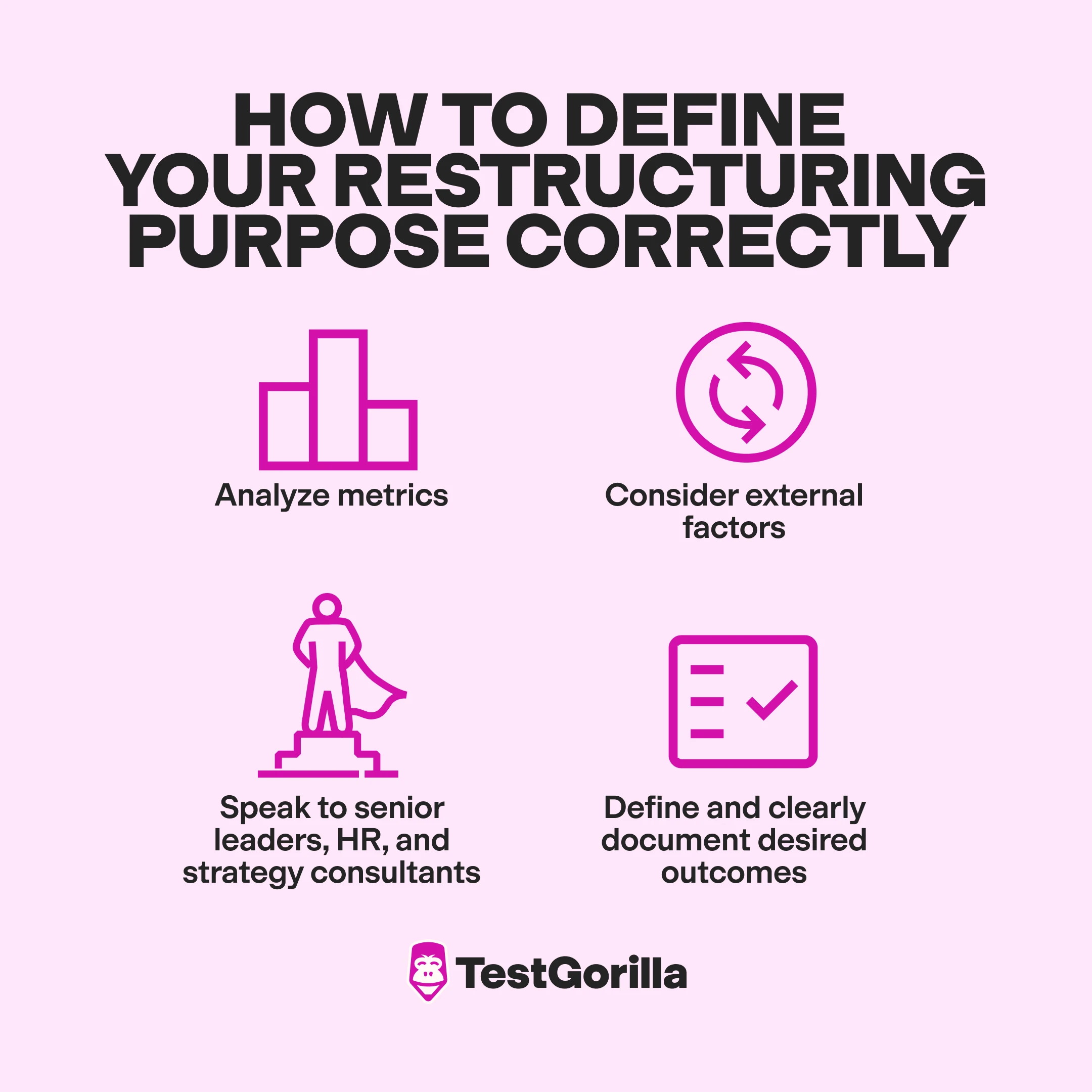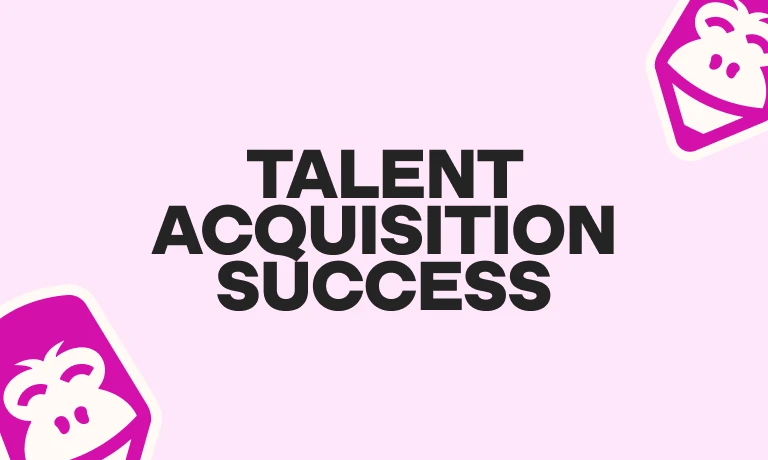Job restructuring involves changing a job's duties, responsibilities, or setup to better meet the needs of a business or its employees.
Here are a few common types of job restructuring strategies.
Task changes: Adjusting the nature of the work – for example, asking writers to switch from traditional to AI-assisted writing.
Schedule changes: Tweaking shifts or work hours – for instance, to accommodate an employee’s caregiving responsibilities.
Combining roles: Merging two roles into one, such as when asking an admin assistant to start managing a company’s Instagram page.
Job sharing: Breaking a role down into multiple roles or splitting the workload between multiple people – for instance, hiring two part-time workers to fulfill the needs of a full-time role.
When is job restructuring necessary?
Job restructuring can become necessary for several reasons – both business and employee-related. Here are some scenarios.
During business changes
With an ever-evolving business landscape and the rise of tech and AI, businesses commonly face shifting goals, changing customer profiles, fluctuating market demand, etc.
These scenarios might call for changes to one or more jobs. For instance, a local gym that builds an app for its members may need to add tech support tasks to its customer service roles to ensure customer satisfaction.
When you must cut costs
During tough financial times, businesses might need to cut back on their costs, and job restructuring could be an effective way to do this without disrupting operations.
Let’s say a small company hired two HR coordinators on payroll. When faced with financial struggles, the company owner could decide to merge the roles into a single HR coordinator role or even change one of the roles into a contractor position for ad-hoc support.
When productivity is low
Sometimes, poor task management and inefficient workflows can lead to low productivity. This is where job restructuring can help streamline operations.
For example, if a business hires an executive assistant and an office manager and the division of duties between them is unclear, important tasks could fall through the cracks. In this instance, reviewing the roles and redefining tasks – or combining the two roles into one – could help boost efficiency and reduce mistakes.
When addressing employee needs
In some cases, job restructuring supports employees’ personal needs. For example, changing a role from a 9-5 to flexible schedule could help a working parent better manage their time and boost job satisfaction. Happy employees are also more productive, engaged, and loyal to the company – some of the longer-term benefits of job restructuring.
3 steps to plan and execute job restructuring effectively
Here's how you can implement your job restructuring process effectively.
1. Define the objectives for restructuring
Without understanding the root cause of restructuring, you might create more problems than you solve. Knowing the "why" ensures the change is in the best interest of the company and helps you manage the change thoughtfully. To define your restructuring purpose correctly:
Analyze metrics such as revenue, customer satisfaction, performance ratings, and employee surveys to spot any themes or issues that could be addressed through restructuring.
Consider external factors like industry trends or economic shifts to identify any needs for change.
Speak to senior leaders, HR, and strategy consultants to decide the type of restructuring you're planning to implement – for instance, job merging, task changes, schedule adjustments, and so on.
Define and clearly document desired outcomes, such as streamlined workflows or flexible roles.
2. Develop and follow your detailed job restructuring plan
Next, create and implement your restructuring plan in a methodical way to ensure you stay compliant, cover essential steps, and minimize disruption.
Plan checklist | Action items |
Establish the changes to be made | - List the specific changes, including which roles are changing and how.
- Define new job descriptions that clearly outline the change in scope.
- Speak with senior management to ensure changes align with company goals and get sign-off on the restructuring. |
Comply with relevant labor laws, regulations, and ethics | - Consult with HR and a legal or compliance expert to understand which laws apply to your restructuring.
- For instance, the Worker Adjustment and Retraining Notification Act (WARN) requires advance notice for layoffs while the Fair Labor Standards Act (FLSA) governs rules for wages and overtime.
- Additionally, make sure you're being fair to employees – for instance, by keeping workloads manageable in job merging or task-changing scenarios. |
Define timelines | - Set a realistic timeline for each phase of restructuring. For instance, you might take anywhere from weeks to months to get sign-off, communicate with employees, offer training, etc.
- Consider rolling out bigger restructures – like team-wide changes – in phases. Start with fewer roles, gather feedback, and move on to the next jobs slowly to minimize disruption. |
Prepare resources | - Identify and prepare the tools, training, and budget needed for restructuring efforts.
- Plan for one-time costs like severance packages if relevant. |
Test job fit | - Once a role is restructured, consider if the existing employee still fits the role or if you need to change employee placements.
- Use talent assessments to check employees' hard and soft skills, cognitive abilities, and attributes to check for job fit and suitability before making job restructuring decisions. |
Communicate and execute | - With support from HR and relevant managers, transparently communicate restructuring plans to employees in one-on-one settings.
- Explain the reasons, how the restructuring impacts the employee, and clarify the process, timelines, and next steps.
- Be open to employee feedback. |
Create a contingency plan | - Have a plan for what to do if things don't go as expected – for instance, if multiple employees decide to resign or if the restructuring results in negative PR on social media. |
3. Monitor outcomes post-restructuring
After restructuring, you must monitor how employees are feeling, track performance and productivity, and ensure the change is effective in terms of business outcomes. Here's how you can do this:
Check in with employees regularly and gather feedback on how they're adjusting in their restructured roles or departments.
Track performance metrics like productivity, error rates, or customer satisfaction to review the effectiveness of the change and identify who needs more support.
Offer continuous training, development, and mentorship to help employees transition into changed roles comfortably.
Compare key performance indicators (KPIs) before and after restructuring – for instance, labor costs, revenue, etc.
Use these insights to adjust and refine your job restructuring process for the future.
The best insights on HR and recruitment, delivered to your inbox.
Biweekly updates. No spam. Unsubscribe any time.
FAQs
Need more information? Check out our answers to some frequently asked questions.
What is employee restructuring?
Employee restructuring – typically called job restructuring – is when a company amends employees’ roles, tasks, schedules, or workflows to better meet the needs of the company and employees. However, some companies might use the term “employee restructuring” to refer to elements of organizational restructuring, which can include workforce-level changes like hiring freezes and team-wide adjustments.
Does restructure mean layoff?
Not necessarily. While some job restructuring efforts involve layoffs, the process often focuses on reassigning tasks and adjusting roles without letting go of employees.
2025 has seen record layoffs. Learn what this means for the labor market.
Related posts
You've scrolled this far
Why not try TestGorilla for free, and see what happens when you put skills first.




















